I hesitate to approach this topic, because all I know about it is from the newspapers, and it is neither linear nor clear. But it does include the lascivious topic of Taxi Dancing, which I can’t resist, so I will have a go at it. And I did learn about the most prolific dance teacher in Minneapolis, whom I would like to salute.
Dancing Schools, by and large, were advertised in two-line classified ads, with no frills, as if they did not want to draw attention to themselves. There were some exceptions.
I can either go by the name of the school, who ran it, the years it was run, or the address, Ye gads.
MODERN DANCING SCHOOL
The Modern Dancing School advertised at 242 Nicollet Ave. from November 25, 1922 to October 21, 1923. Dancers were provided with orchestra music. Lessons were free to gentlemen, and for an extra charge, private lessons could be had from one of 30 lady instructors, said an ad from December 21, 1922, in the Tribune.
From here the school moved to 23 Sixth Ave. No. from November 2, 1923 to November 9, 1926.
In May 1926, its dance hall license was in peril, following complaints by investigators of the Women’s Co-Operative Alliance. It was stated that the management of this and other dance halls employed young women as dancing partners for patrons and the committee opposed this policy. The proprietor of the Modern Dancing School at this time was R. J. Brewer.
This pressure may have caused a problem, but we see that the Modern Dancing School carried on for a little while, moving to 44 So. Sixth Street from November 24, 1926 to February 7, 1927.
KNICKERBOCKER DANCING STUDIOS – 904 Hennepin
This Dancing Studio first shows up in the classified on August 29, 1922, at 904 Hennepin Ave. It was run by Mr. and Mrs. S.D. Stocking. The building was located next to the Orpheum Theater, built in 1921 and still there.
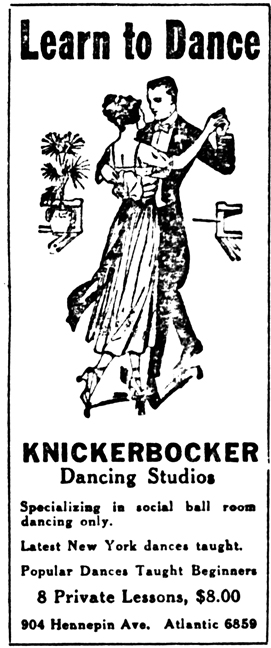
Minneapolis Tribune, October 22, 1922
While running other Dance Schools, the Stockings also ran this Knickerbocker Studio, and it was under this name that they performed exhibitions at other venues like the Marigold Ballroom (which he managed in 1927),
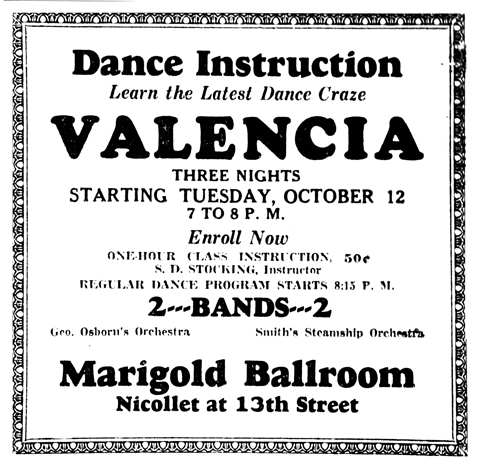
Minneapolis Star, October 9, 1926
and the Flame Room at the Radisson Hotel.
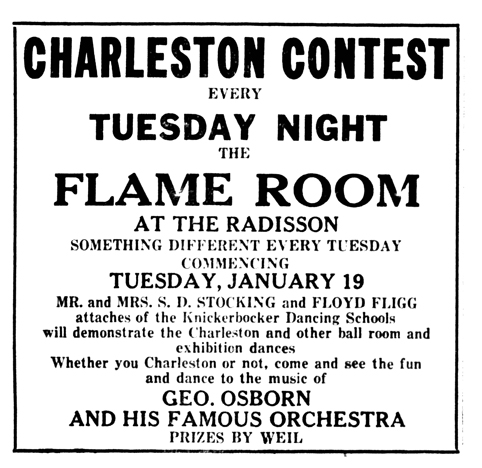
Minneapolis Tribune, January 18, 1926
Ads can be found for 904 Hennepin until June 25, 1942.
UP TO DATE DANCING SCHOOL
Backing up a little, we go to 1924, and 242 Nicollet Ave. The Modern Dancing School has moved on, and now it is unclear who had the dance hall permit for the third floor for this enterprise – S.D. Stocking or Walter Smith. The first mention in the ads appears to be February 9, 1924, and the enticements included 50 potential female partners and the most popular Moore’s Concert Orchestra to provide the music.
On February 10, 1926, Dan Stocking applied for a dance hall permit for the third floor hall, but was denied on March 2, 1926.
He applied again on April 15, 1926, but as with the Modern Dancing School above, based on complaints by the Women’s Co-Operative Alliance, the license Committee recommended denial of Stocking’s permit because he proposed to employ women as partners. Stocking responded that the young women he employed were members of clubs sponsored by Women’s Christian Associations. He requested that the Committee reconsider its action and promised to operate only a dancing school in the future. The Committee reconsidered based on that promise. The Women’s Alliance objected, saying that if a dance hall license were isued, the public could attend dances at Stockings’ dance hall. (Minneapolis Tribune, May 27, 1926)
Ads for Up To Date disappeared after May 1926 and Palm’s Dancing School was in business on June 2, 1926.
PALM’S DANCING SCHOOL
Dan Stocking ran his Palm’s Dancing School at 242 Nicollet starting in June 2, 1926.
In 1928 and 1929, Stocking’s dance hall permit was approved at 242 Nicollet, provided not more than 250 people were allowed on the floor at one time, based on the recommendation of the building inspector.
From about 1932 to 1936, the third floor was sometimes referred to as the Palm Ballroom. And he was still using the Knickerbocker name occasionally.
On September 1, 1936, Stocking was issued a dance hall license for 703 Hennepin Ave., third floor. He also received a license to sell soft drinks.
On October 4, 1936, we see a first ad for Palm’s Dancing School in the new Hennepin location. Seven private lessons for $4, waltz and foxtrot. The ads are only two-line affairs, in the classifieds under Dancing Schools. Unfortunately, there are no snappy ads to reproduce here. And it is safe to say that they used records instead of live orchestras to accompany the dancers. Stocking remained teaching at Palm’s Dancing School until 1978, when he was 81.
Miraculously the building still exists on 7th and Hennepin, even if it isn’t the most beautiful of our ancient relics.
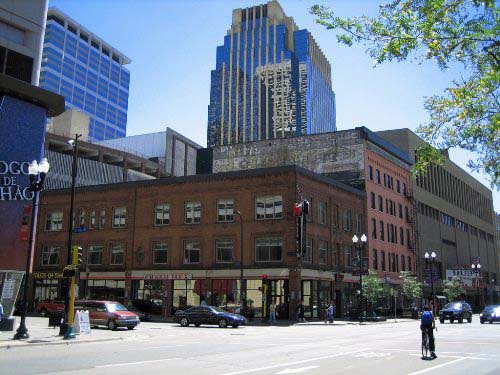
THE RIVIERA DANCING SCHOOL
Backing up again, we visit the Riviera Dancing School, Minneapolis’s first blatant Taxi Dancing establishment, located at 703 Hennepin Ave. The Riviera was the brainchild of James Whitlock, and opened on December 3, 1932. The ad touting their Gala Opening promised “Competent Instructresses Available – Pay as you Dance.” Whitlock made no bones about the fact that this was a Taxi Dance establishment!
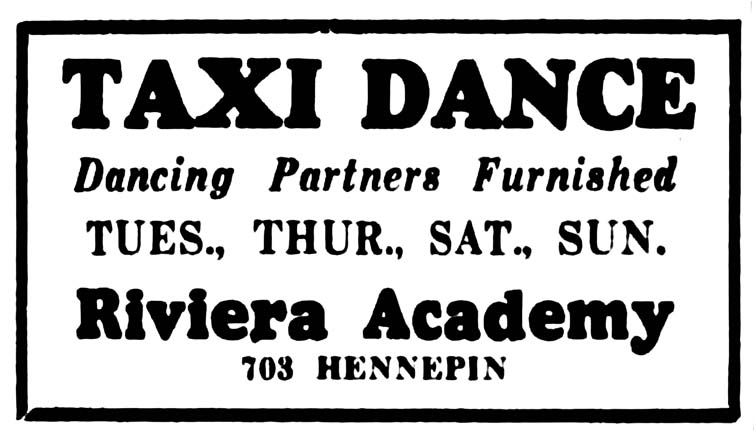
Minneapolis Star, December 8, 1932
Alderman Josiah H. Chase said he noticed a man with a sandwich board outside the place passing out cards, and requested a report from the police. Police woman Blanche Jones checked out the situation and didn’t like what she saw. Taxi Dance places weren’t exactly illegal in Minneapolis, but were certainly distasteful and enough for the license committee to consider revocation of the dance hall license. Specifically, Mrs. Jones found:
- Hostesses smoking on the dance floor
- Lights turned down very low
- Hostesses wearing very suggestive gowns
- Managers charging 10 cents a dance, with the hostess getting 4 cents of the 10. Mrs. Jones noted that other dance halls had cut their price for an entire evening to 25 cents.
Proprietor James Whitlock protested that it really was a dancing school, catering to “gentlemen along in age, many of them professional men” who needed extra confidence from the hostesses once they had learned the steps. (Minneapolis Star, January 12, 1933)
A sympathetic piece appeared in the Minneapolis Tribune on January 13, 1933, showing that the young women who worked at the Riviera made 75 or 80 cents as an average wage each night and that it really helped put food on the table. Several of the women were married, with their husbands out of work in this deep Depression year.
On January 14, 1933, the City Council returned the matter of the Rivera’s license back to the license committee. Meanwhile, despite the TAXI DANCE ad of December 8, 1932 (above), proprietor Whitlock denied that his place was a taxi dance hall and claimed it was a dancing school. (Minneapolis Star)
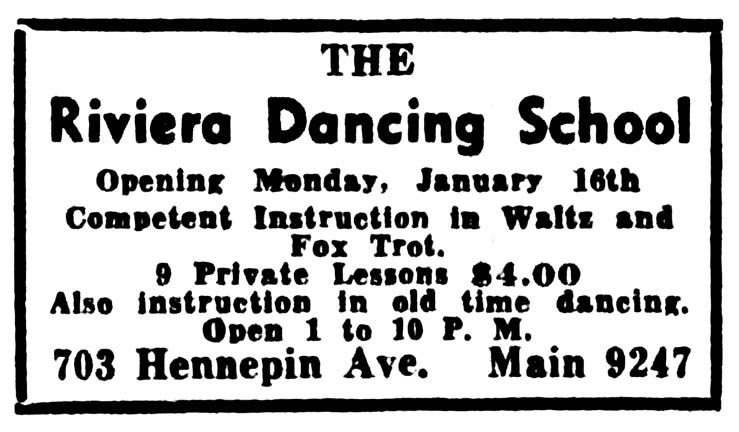
Minneapolis Tribune, January 15, 1933
After threats of revoking the school’s license, another ad appeared, showing the place opening on January 16, 1933. Nine private lessons in the waltz and fox trot could be had for $4. Also instruction in “old time” dancing. It was operating pending the committee’s decision on revoking the license.
In February 1933, Mrs. Jones came back to the committee with a positive report.
But that was the last we can find of the Riviera Dancing School.
SIDNEY DANIEL “DAN” STOCKING
Dancing Dan Stocking taught dancing to thousands of people from his various dancing schools and studios in Minneapolis for 57 years.
Born in Rockport, Indiana, on April 4, 1896, Dan started taking dancing lessons when he was 13. “But even as a little boy I was always dancing down the street.” In 1917 he ran a moving picture show, and from May 1918 to January 31, 1919, he served in World War I.
He opened his first dancing school in Chicago in 1919, but says he refused to pay protection to the mobsters, so one night his place was bombed.
Minneapolis was his next stop. His first school here was the Knickerbocker Dancing Studios, which he opened in August 1922 with his wife at 904 Hennepin, next to the Orpheum Theater. He had danced in many shows in the old Orpheum vaudeville circuit. In 1922 he was the winner of the professional Dancing Championship, held in Chicago. In 1923 he won the prestigious Valentino Cup, presented to him by Rudolph Valentino and his wife personally.
He taught many celebrities to dance, including band leaders Horace Heidt and Frankie Carle, and the Andrews Sisters.
Stocking retired in 1978, and by 1981 he was confined to a wheelchair in a nursing home in St. Louis Park. Even so, he continued to teach dancing to residents and staff. In October 1982, he and an assistant performed a ballroom and classical ballet in his wheelchair at the Pillsbury House.
Each birthday was celebrated with a tribute at a local ballroom such as the Prom or the Bel-Rae. Is that picture below supposed to be Jules or Dan?
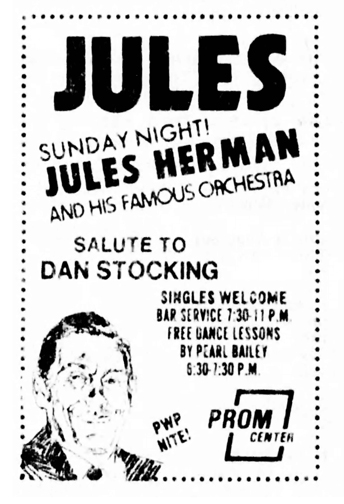
Minneapolis Tribune, April 14, 1978
Dan Stocking died on November 29, 1987, in Minneapolis at the age of 91. He was well loved.
Sources:
Robert T. Smith, Minneapolis Tribune, May 26, 1976
Minneapolis Tribune, March 10, 1978
Barbara Flanagan, Minneapolis Star, May 29, 1981
Minneapolis Tribune, October 8, 1982
